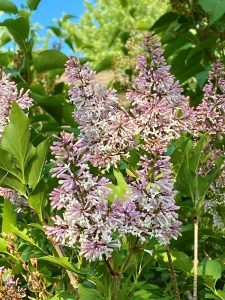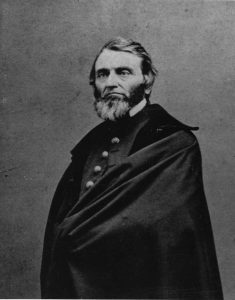Newly-discovered accounts of Mackinac Island’s lilacs from the 1840s.
 Blooming lilacs are now just a memory for the 2023 season. These sweetly-scented flowering shrubs typically bloom between mid-May and mid-June in northern Michigan. For many years, the earliest known reference to lilacs on Mackinac Island was by the famous author and naturalist Henry David Thoreau. Suffering from tuberculosis, Thoreau visited the island from June 30 – July 4, 1861, with Horace Mann Jr., a seventeen-year-old budding botanist and loyal traveling companion. Thoreau’s unpublished journal emphasizes the lateness of spring, recording about 30 species of trees and shrubs and more than 75 varieties of herbaceous plants and wildflowers. Thoreau noted, “No corn or only green corn. Strawberries (both kinds) hardly ripe here & scarce.” He also observed “apple in blossom … & lilac.”
Blooming lilacs are now just a memory for the 2023 season. These sweetly-scented flowering shrubs typically bloom between mid-May and mid-June in northern Michigan. For many years, the earliest known reference to lilacs on Mackinac Island was by the famous author and naturalist Henry David Thoreau. Suffering from tuberculosis, Thoreau visited the island from June 30 – July 4, 1861, with Horace Mann Jr., a seventeen-year-old budding botanist and loyal traveling companion. Thoreau’s unpublished journal emphasizes the lateness of spring, recording about 30 species of trees and shrubs and more than 75 varieties of herbaceous plants and wildflowers. Thoreau noted, “No corn or only green corn. Strawberries (both kinds) hardly ripe here & scarce.” He also observed “apple in blossom … & lilac.”
Recently, two earlier accounts of Mackinac Island lilacs were discovered, both from the 1840s. On a trip from Xenia, Ohio, William Mills penned a letter home on July 3, 1847. Published in the Greene County Torch-Light on July 15, his longer column concludes,
“But lest I become too prosy, I will finish with a glance at the particularly interesting and picturesque locality of Mackinac … We reached here about sunrise this morning and all walked upon the island and inspected whatever of interest came our way. Mackinac is on the 46th degree of latitude, some 450 miles north of Xenia, and now the fresh blooming lilac and opening buds of the apple tree, too plainly told the chilliness of a late spring … We had some invalids among us when we left home, but there are none on that list now, if hearty appetites and a full flow of playful spirits are considered the signs.”

Interestingly, William Mills was a founder of Antioch College, whose first president was the noted American educator, Horace Mann. Their families were undoubtedly familiar, with Horace Mann Jr. attending the school in 1859, just two years before his own trip to Mackinac Island.
Currently, the earliest known account of Mackinac’s lilacs was written June 18, 1845, by “J.I.M.” an unknown correspondent from The Boston Post. His visit was described in rich detail through a series of letters, reprinted that July. After securing comfortable accommodations at the new Mission House hotel, he spent several days exploring the island’s natural wonders. “Jim” penned a goodbye note aboard the steamer Madison as it pulled from the harbor. He wrote,
“Adieu, beautiful island of Mackinac! … Farewell to your rocks and caves, your shady walks and stony beach, your clear air, sweetened by the lilac and apple trees but just in blossom – your delicious trout and white fish, and the kind hospitality of your people! all, farewell.”
Local lore places the origins of Mackinac Island’s lilacs even earlier than the 1840s. Today, the oldest known trees are about 200 years old, placing them among the eldest specimens in the nation. If treated with care, the island’s clear air will be sweetened by lilacs for centuries yet to come.









